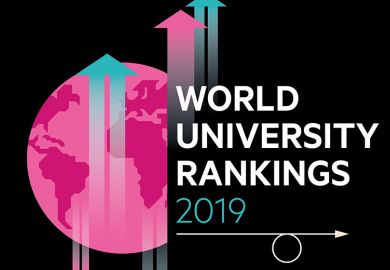Browse the full results of the World University Rankings 2019
“All universities – certainly, all great universities – adapt and adjust and remake themselves; if they didn’t, they would not stay great for long. But there is probably no university that has transformed itself as dramatically and as positively as New York University has over the past three decades.”
These words from NYU’s president Andrew Hamilton are bold, but the evidence suggests that they are not necessarily unjustified.
Figures from the National Science Foundation’s Higher Education Research and Development Survey suggest that NYU’s research and development expenditures increased by a greater percentage between 2010 and 2016 than those of any of the other top 40 universities in the US.
Since 2011, NYU has moved up 33 places in the Times Higher Education World University Rankings. It is now ranked 27th, having overtaken Brown University, the Karolinska Institute and the University of Edinburgh, to name just a few, during that time.
Hamilton, who was vice-chancellor of the University of Oxford from 2009 to 2015 and provost at Yale University before then, says that he “had my eye on NYU for quite some time from my previous positions”.
“Frankly, I think leaders at a lot of universities did. There is something immensely appealing about being part of a university that clearly has so much academic momentum; I was drawn to it,” he says.
One important reason for this is, of course, that universities in Germany (and many others in continental Europe) are not residential campus institutions like their Anglo-American counterparts. In addition, most German universities have always run a rather restrictive course concerning public events, and they usually do not allow events of political parties and movements on their premises.
THE World University Rankings 2019: results announced
A new THE analysis of the different “academic clusters” of institutions in the rankings reveals some insights into how NYU has improved over time.
The clusters – which THE ’s data team created by mapping institutions’ citation scores and reputation votes across 11 subject areas – range from “old stars” that have the strongest academic reputations and broadest citation impact across disciplines, through to up-and-coming groupings such as the “international powerhouse” universities and “life science/ technology challengers” to those in the “core strengths” cluster, which have solid research profiles but are less known in academic circles.
The 2019 rankings data show that just two universities moved from the “international powerhouse” group to become “old stars” this year: the University of Pennsylvania and New York University.
International powerhouse universities tend to show slightly more expertise in clinical subjects than their peers in the old stars category, and slightly less ability in the arts, and they generally do not have the same broad recognition across many areas of expertise as old stars.
But Hamilton rejects the notion that NYU has tried to emulate its peers and competitors, claiming that “boldness is part of NYU’s allure, and that’s accompanied by an institutional comfort with charting a different course”.
“NYU has made choices in the past 45 years – giving up its main campus in the Bronx and consolidating in Greenwich Village; building programmes, dorms and facilities to boost itself from a regional school to a research university of international stature; establishing an unrivalled global presence; merging with the former Polytechnic University, thereby both restoring engineering and establishing a presence in Brooklyn just as that borough’s fortunes are taking off – that most universities would be hesitant to make,” he says.
Old stars, ranked by overall score in World University Rankings 2019
|
World rank 2019 |
University |
Country |
|
1 |
United Kingdom |
|
|
2 |
United Kingdom |
|
|
3 |
United States |
|
|
4 |
United States |
|
|
6 |
United States |
|
|
7 |
United States |
|
|
8 |
United States |
|
|
10 |
University of Chicago |
United States |
|
=12 |
United States |
|
|
14 |
UCL |
United Kingdom |
|
15 |
United States |
|
|
16 |
United States |
|
|
17 |
United States |
|
|
20 |
University of Michigan |
United States |
|
21 |
Canada |
|
|
27 |
United States |
Another rising star in the ranking is China’s Tsinghua University, which moves from the “regional stars” group this year to become an “international powerhouse”.
Many of the most established institutions in Asia and Russia, with the strongest regional reputations, are regional stars and they tend to be particularly strong in the physical sciences and engineering and technology. However, they are generally weaker in the arts and social sciences and tend to be less outward-looking, with a much lower international score than other universities.
Tsinghua has boosted its scores in all three international outlook metrics this year: share of international students, international staff and international research collaboration.
The Technical University of Munich is also a new powerhouse member, after moving from the “technology challengers” group – a cohort characterised by a focus on physical sciences and engineering and technology, and high industry income scores. International powerhouse universities tend to be much stronger when it comes to citation impact, which can have a knock-on effect on reputation.
TUM has a strong citation score and received a boost to its teaching reputation this year. It also attracted more international staff and students.
Gerhard Müller, TUM’s senior vice-president for academic and student affairs, says that the institution now offers more than 40 degree programmes in English and is making the transition to English as the teaching language for almost all master’s programmes.
A new tenure track system at the institution, launched in 2012, has also helped the university recruit scholars from some of the most prestigious universities in the US and the UK, he says.
“Because of our extraordinary range of subject areas, extending from engineering, medicine, natural and life sciences to economics and social sciences, we are in a better position than other universities to offer students highly interdisciplinary formats that prepare them for the complex challenges of the future,” he adds.
While the academic clusters reveal groups of institutions with similar characteristics, NYU’s Hamilton suggests that they also prove that there is not one single strategy for making progress.
“Paradoxically, the fact that NYU wasn’t an ‘old star’ is precisely what has enabled it to reach such heights in such a relatively short time. Rather than gazing reverentially at a golden past, NYU has been able to focus firmly on its present and its future,” he says.
“So, if there is a lesson to be drawn here, it may be this: there is more than one path to attain educational excellence.”
Register to continue
Why register?
- Registration is free and only takes a moment
- Once registered, you can read 3 articles a month
- Sign up for our newsletter
Subscribe
Or subscribe for unlimited access to:
- Unlimited access to news, views, insights & reviews
- Digital editions
- Digital access to THE’s university and college rankings analysis
Already registered or a current subscriber? Login

















